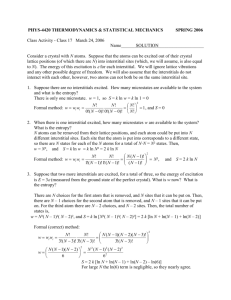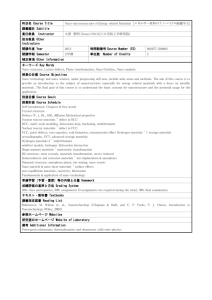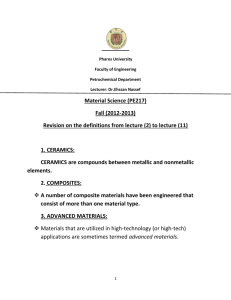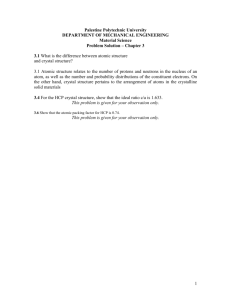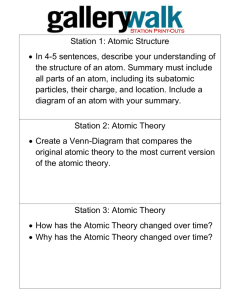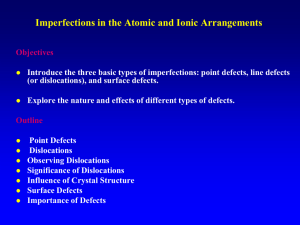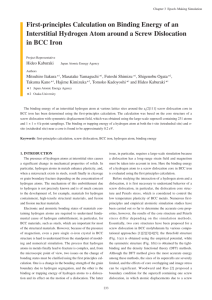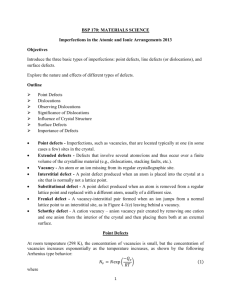Name: MME 2001 MIDTERM # 1
advertisement
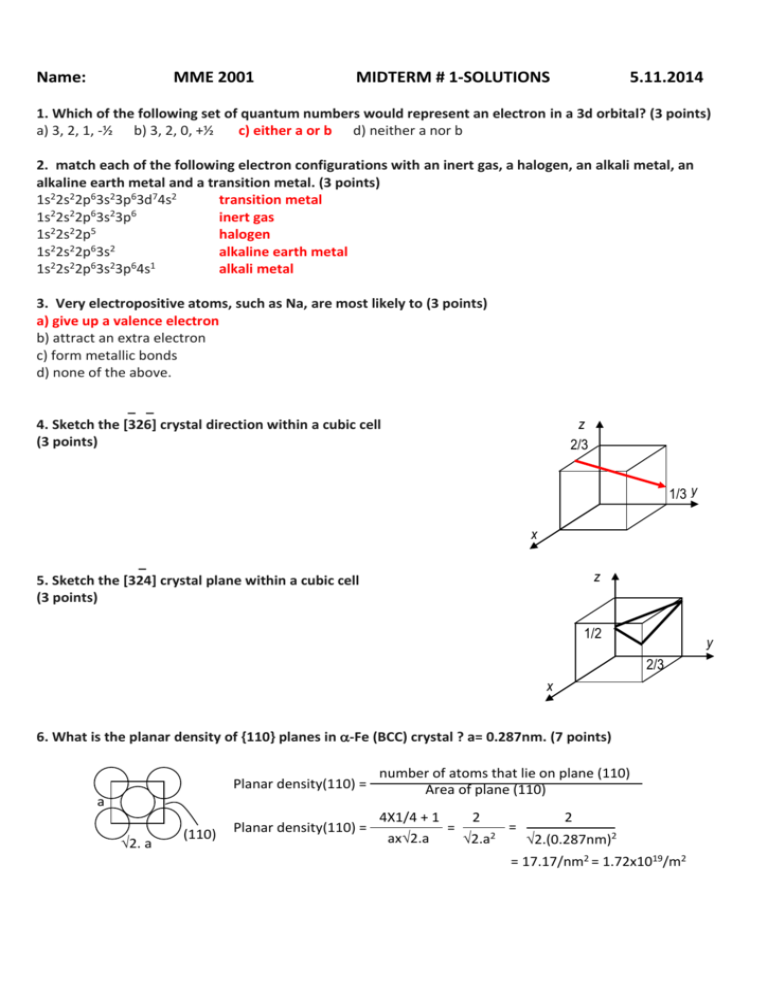
Name:
MME 2001
MIDTERM # 1-SOLUTIONS
5.11.2014
1. Which of the following set of quantum numbers would represent an electron in a 3d orbital? (3 points)
a) 3, 2, 1, -½ b) 3, 2, 0, +½
c) either a or b d) neither a nor b
2. match each of the following electron configurations with an inert gas, a halogen, an alkali metal, an
alkaline earth metal and a transition metal. (3 points)
1s22s22p63s23p63d74s2
transition metal
1s22s22p63s23p6
inert gas
2
2
5
1s 2s 2p
halogen
2
2
6
2
1s 2s 2p 3s
alkaline earth metal
1s22s22p63s23p64s1
alkali metal
3. Very electropositive atoms, such as Na, are most likely to (3 points)
a) give up a valence electron
b) attract an extra electron
c) form metallic bonds
d) none of the above.
_ _
4. Sketch the [326] crystal direction within a cubic cell
(3 points)
z
2/3
1/3 y
x
_
5. Sketch the [324] crystal plane within a cubic cell
(3 points)
z
1/2
y
2/3
x
6. What is the planar density of {110} planes in -Fe (BCC) crystal ? a= 0.287nm. (7 points)
Planar density(110) =
number of atoms that lie on plane (110)
Area of plane (110)
Planar density(110) =
4X1/4 + 1
2
2
=
=
2
ax2.a
2.a
2.(0.287nm)2
a
2. a
(110)
= 17.17/nm2 = 1.72x1019/m2
7. What is the linear density of [110] direction in a Cu (FCC) crystal? a= 0.361nm. (7 points)
a
linear density[110] =
number of atoms that sit on [110]
length of [110] vector
linear density[110] =
2x1/2 + 1
2
=
2.a
2.(0.361)
[110]
a
(100)
= 3.92/nm = 3.92x109/m
8. A metal with BCC crystal structure has a density of 0.971 g/cm3, and an atomic weight of 22.99 g/mole.
What is the atomic radius of this metal? (7 points)
Atomic weight= 22.99 g/mole 22.99/(6.022x1023) = 3.82.10-23 g/atom
BCC unit cell has 2 atoms: 2x3.82.10-23 = 7.64.10-23 g/unit cell; 7.64.10-23 g/a3
For BCC; a=4R/3
7.64.10-23 g/(4R/3)3 = 0.971g/cm3= 0.971 g/1021 nm3= 9.71x10-22 g/nm3
Solve for R
7.64.10-23 g/(4R/3)3 = 9.71x10-22 g/nm3
R=0.186nm
9. How is interatomic bonding energy linked with the melting point and thermal expansion coefficient of
materials?
Rank the following elements in terms of their melting temperatures and thermal expansion coeffients from
the highest to the lowest. (7 points)
substance
Al
Fe
W
Bonding energy, kJ/mol
324
406
849
Melting point increases with increasing bonding energy.
Thermal expansion coefficient decreases with increasing bonding energy.
Al: lowest melting point/Fe/ W highest melting point
Al: highest thermal expansion coefficient/Fe/ W: lowest thermal expansion coefficient
10. Briefly explain the isotropy and anisotropy? Are amorphous materials anisotropic or isotropic? Are
single crystals anisotropic or isotropic?
This directionality of properties is termed anisotropy. Anisotropy is associated with the variance of atomic
spacing with crystallographic direction. Isotropy refers to the case when these properties are independent of
the crystal direction.
Amorphous materials do not have a crystallographic order; directionally does not exist; hence they are
isotropic!
Single crystals are anisotropic as they have only a single crystal orientation!
11. Using Cu K x-rays (=0.1541nm), diffraction from the (111) planes in FCC nickel is observed at 2=44.5
degrees. What is the lattice parameter of Nickel? (7 points) (assume first order diffraction, n=1)
=2 (a/3) sin (22.25)= 0.1541nm
Solve for a a= 3(0.1541nm)/2(sin22.25)= 0.354nm
12. In view of the following data, would you predict more Al or Zn to dissolve in copper? Why? (7 points)
Element
Cu
Al
Zn
atomic radius (nm)
0.1278
0.1431
0.1332
x’tal structure
FCC
FCC
HCP
electronegativity
1.9
1.5
1.6
valence
+2
+3
+2
More Zn will dissolve in Cu. Due to the proximity of the atomic radius of Zn with respect to that of Cu.
13. Identify the imperfections (1 to 5 in Fig. 1,6 in F,g. 2, and 7 and 8 in Fig. 3) and briefly explain each one!!
(7 points)
6
7
8
Fig. 1
Fig. 2
Fig. 3
1: vacancy : a vacant site
2: self interstitial: own atom displaced to an interstitial site
3: interstitial (impurity): impurity atom at an interstitial site
4: substitutional (impurity): impurity atom at a lattice site
5: substitutional: impurity atom at a lattice site
6: twin: a planar imperfection produced by twinning
7: high angle grain boundary: the boundary between two grains with a large difference in the orientations
8: low angle grain boundary: the boundary between two grains with a large difference in the orientations
14. A) Which of the following statements is correct? (3points)
a) the Burgers vector of an edge dislocation is perpendicular to its dislocation line.
b) the Burgers vector of a screw dislocation is parallel to its dislocation line.
c) mixed dislocations have varying degree of edge and screw character
d) all of the above
15) which of the following statements is wrong?
a) a kink is a step in the line of an edge dislocation outside the slip plane
b) a kink is a step in the line of a screw dislocation outside the slip plane
c) a jog is a step in the line of an edge dislocation inside the slip plane
d) all of the above
16. What is the fraction of atom sites that are vacant for lead at its melting temperature of 327°C?
Qv=0.55eV/atom (7 points)
Nv/N = exp(-Qv/kT) = exp [-0.55/(8.62x10-5)600] = 2.41x10-5
17. a) Substituional diffusion of Ni (solute) in Cu (solvent) (3 points)
a) is a thermally activated process (improves with Temperature)
b) occurs faster with increasing temperature
c) requires existence of vacancies
d) all of the above.
18) With increasing melting point, the activation energy for diffusion generally is
a) higher
b) lower
c) the same
d) the two are not related!
19. For the diffusion of carbon in iron, Q=142 kJ/mol and D0=2X10-5 m2/s. Estimate the diffusion coefficient
of carbon in iron (D in m2/s) at 927C (R=8.31 J/mol-K) (7 points)
D= D0 exp (-Qd/RT) = 2x10-5 exp (- 142000/8.31x1200) = 1.32x10-11 m2/s.
20. An iron plate is exposed to a C-rich atmosphere on one side and a decarburizing (C-deficient)
atmosphere on the other side at 700 C. Assuming steady state conditions are achieved calculate the
diffusion flux of Carbon through the iron plate if the C concentrations at 2 and 8 mm beneath the
carburizing surface are 1.0 and 0.6 kg/m3, respectively. D = 3.10-11m2/s (7 points)
J= -D (CA-CB)/xA-xB = - (3x10-11) [(1.0-0.6)/(2x10-3-8x10-3)] = 2x10-9 kg/m2.s

